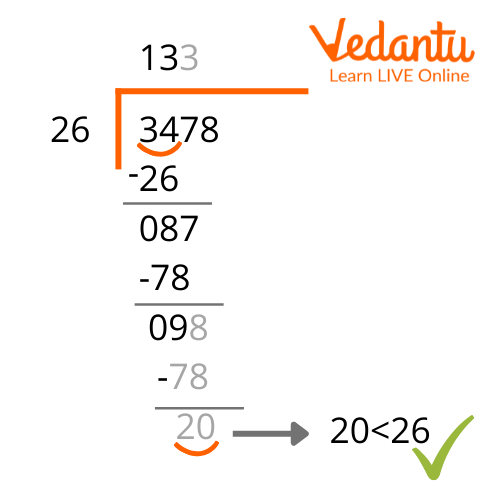




Simple Tricks to Divide Two-Digit Numbers Faster
Division is the process of dividing a group of things into equal parts. There are 4 things to know about while dividing, i.e. dividend, divisor, quotient, and remainder. The two-digit division is a very small calculation and does not involve too many steps.
Dividend is the number that is being divided. Divisor is the number by which the dividend is being divided. Quotient is the result of division. Remainder is the amount that is left after the division. Division is the tool used to separately distribute objects among different people in equal numbers. Let’s see the division of 2-digit numbers in more detail.
Process of Division
The following discusses the process of division in a step-by-step manner.
Let's take the first digits of the dividend which should be equal to the number of digits that the divisor has.
The number that is taken from the dividend is smaller than the divisor, we take the next digit of the dividend.
We begin by dividing the first number of the dividend by the first digit of the divisor.
The result of that division has to be written in the space of the quotient.
The digit of the quotient is multiplied by the divisor, and the result is written below the dividend and subtracted.
But in case the dividend is a smaller number we cannot do so. Therefore, we will need to choose a smaller number in the quotient till the time we can subtract it.
Once we perform the subtraction, use the next digit of the dividend and repeat the process of the division until the point where there are no more remaining numbers present in the dividend.

Three Aspects in a Division
Two-digit Division Questions: Solved Examples
In the below examples, we will solve some problems based on two-digit division questions.
Example 1. Divide 94 by 12.
Ans: The number 12 is multiplied by the number 7 so that it equals 84.
94 - 84 = 10
Quotient = 7
Remainder = 10
Example 2. Divide 96 by 16.
Ans: The number 16 is multiplied by 6, so that equals 96.
Quotient = 6
Remainder = 0
Example 3. Divide 88 by 17
Ans: The number 17 is multiplied by 5, so that equals 85.
Quotient = 5
Remainder = 3
Example 4. Divide 192 by 24
Ans: The number 24 is multiplied by 8, so that equals 192.
Quotient = 8
Remainder = 0
Example 5. Divide 51 by 32
Ans: The number 32 is multiplied by 1, so that equals 32.
Now, 51 - 32 = 19
So, 190 is left which is divided now.
Now, again, 32 is multiplied by 5, so that equals 160.
Now, 190 - 160 = 30
Quotient = 15
Remainder = 30
6. Divide 275 by 24
Ans: The number 24 is multiplied by 1, so that equals 24. Now, 27 - 24 = 3
Therefore, 35 is now the dividend. Now, again, 24 is multiplied by 1, so that equals 24
35-24 = 11
Quotient = 11
Remainder = 11
7. Divide 803 by 70
Ans: The number 70 is multiplied by 1, so that equals 70. Now, 80 - 70 = 10
Therefore, 103 is now the dividend. Now, again 70 is multiplied by 1, so that equals 70.
103 - 70 = 33
Quotient = 11
Remainder = 33
8. Divide 345 by 49
Ans: The number 49 is multiplied by 7 so that equals 343. Now, 345 - 343= 2
Therefore, 2 cannot be divided further as the divisor is much larger than the dividend.
Quotient = 7
Remainder = 2
9. Divide 4963 by 14
Ans: The number 14 is multiplied by 3 so that equals 42. Now, 49 - 42 = 7
Therefore, 763 is now the dividend but we use only 76. Now, again 14 is multiplied by 5 so that equals 70.
76 - 70 = 6
Now, 63 is the dividend and we multiply 14 with 4 so that equals 56
63 - 56 = 7
Quotient = 354
Remainder = 7
Practice Problems
Q1. Divide 300 by 15
Ans: 20
Q2. Divide 155 by 25
Ans: Quotient = 6, Remainder = 5
Q3. Divide 267 by 30
Ans: Quotient = 8, Remainder =27

Two-Digit Division in Steps
Summary
Division is an important tool for calculation in Mathematics. The four components of division are divisor, dividend, remainder, and quotient. This process of division involves subtraction as well, and it allows us to complete the division by using up all the values of the dividend. Some sums of two digit division questions are discussed in detail and then in practice problems sums are given for practising. We hope now you will no longer struggle with division and enjoy Maths even more.
FAQs on Division of Two-Digit Numbers Made Easy for Students
1. What is the importance of division?
We can divide something into parts but whenever the dividing parts are more and the dividend value is large, we need to use the division rules and follow the process to find the right amount. Division leads to the quotient which is basically the number of parts a dividend can be divided into. If the value of dividend is not divisible by the divisor then a remainder can be found at the end of all steps. This value is what cannot be divided equally.
2. What is the use of division in everyday life?
The process of division involves separately grouping a lot. The application of division is in the equal separation of objects into various groups. It is used to share equally between people, to divide goods, etc.
A very regular example can be the sweets distributed on Independence Day. If there are 200 students and there are 400 sweets, then we can say that 2 sweets each will be received by every student.
3. In a two-digit division, what is the use of a divisor?
The divisor is the two-digit number in a two-digit division that is used to divide the dividend or the number which we need to divide in equal parts. The division can be stated as the total number of parts the dividend has to be divided into. For example, if we need to divide a cake among 5 kids, we shall cut the cake into 5 pieces here the divisor or the number of pieces is 5.











